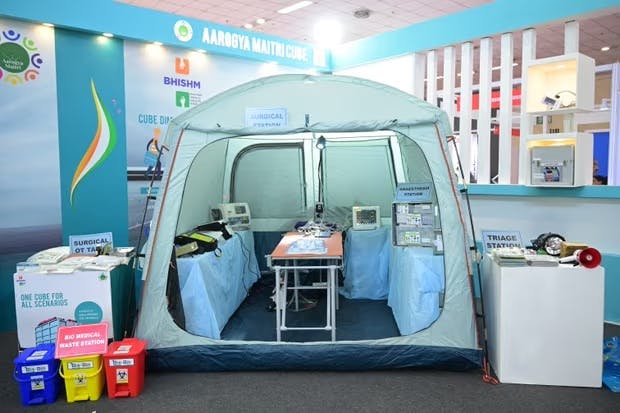A whole field hospital—delivered by airdrop
An earthquake. A flood. An act of war.
In the face of any mass casualty event, time is of the essence. Medical responders need to be able to provide care ranging from basic first aid to advanced surgical intervention. Especially when terrain and conditions are challenging, getting ambulances and even helicopters to transport patients isn’t always an option.
The Indian government has developed an innovative solution to on-the-ground disaster health response: A hyper-portable field hospital.
The “flatpack” field hospitals can be deployed within 12 minutes, airdropped via helicopter, and assembled faster than Ikea furniture. Once they’re up and running, each unit can treat up to 200 patients.

What does it take to set up a bare-bones field hospital?
If you ask the team behind the Aarogya Maitri Aid Cube, all you need is five trained people and one hour of assembly.
“Usually, aid does not reach [a] calamity-hit region the first day,” said Wing Commander Sanjay Kumar, a member of the National Task Force. “With this, we can provide aid in no time and save lives. This swift deployment capability is crucial as it effectively bridges the crucial time gap from primary care to definitive care. Meticulous tests were carried out like paradropping the cubes from helicopters and drones. This can revolutionize the healthcare sector.”
The whole hospital comes together from 72 small waterproof cubes, each under 15 kg and about 15 cubic inches.
The facility includes:
- A mini ICU
- An operating room
- Ventilators
- Blood testing equipment
- An X-ray machine
- A tablet with BHISHM software that monitors inventory for current usage and future deployment
- A cooking station
- Food, water, and shelter
- A power generation
With all of this equipment, providers using the Aid Cube can perform approximately 20 different surgeries and 72 different tests. They can treat conditions ranging from gunshot wounds to fractures.
The innovation came together under Project BHISHM (Bharat Health Initiative for Sahyog, Hita, and Maitri), a joint initiative of the Ministry of Health, the Ministry of Defense, and the National Security Council.
Our perspective: Medical innovation where it’s needed most
As much as medical innovators may wish that we can eradicate all human suffering, disasters and wars will continue happening. What we can do is optimize our response to these events, to minimize impacts on individual and population health.
Some of the most exciting work being done in medtech today is in this arena. The Aid Cube joins an exciting list of recent headlines. Last month, we brought you a story about warzone-based medical device 3D-printing operations led by the Glia Project. We’re also thinking about innovators using delivery drones for emergency response and opioid overdose treatment.
Plus, one of the most encouraging parts of the Aid Cube project is that it’s not just a boon for India. The government has pledged to provide access to medical supplies like the Aid Cube to any developing countries affected by natural disasters or other humanitarian crises.
This innovation appears to be intended for the health of the world. While small, the impact of these portable hospitals has the potential to be mighty.